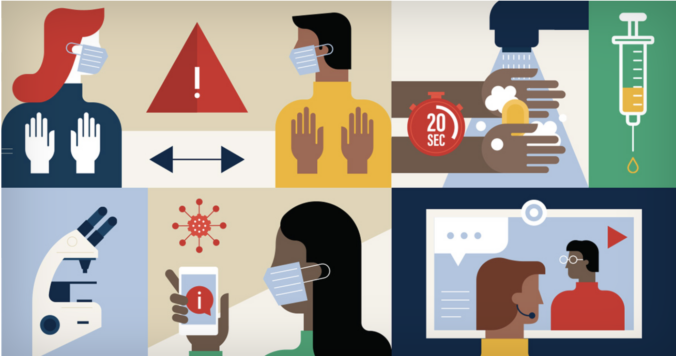A new survey of higher education institutions reveals surprising details of the significant challenge universities face trying to effectively address indoor air safety during the COVID-19 pandemic. While most schools in the United States (roughly 80%) made changes to improve ventilation, they too often made large investments that may not have yielded the improved indoor air quality (IAQ) they expected. The survey was commissioned by Omni CleanAir, a maker of commercial-grade air cleaning systems.
“Higher education institutions faced a clouded landscape in the air quality industry, wading through opaque efficacy data that, in some cases, misled stakeholders. Many schools have simply been unable to make informed investment decisions about indoor air quality solutions,” said Paul de la Port, president of Omni CleanAir. “While these organizations invested huge sums to tackle the issue of safe air, easily measurable results are lacking.”
Conducted in September 2021, the nationwide survey polled 500 higher education managers and executives. The survey asked respondents to rank the importance of various COVID-19 precautions and defense measures, their knowledge of indoor air quality topics, and their budgets and spending forecasts. The margin of error was +/- 5%, with a confidence level of 95%.
From HVAC to Ionization Tech, Universities Chase Clean Air Results
Survey data show that the most common approach to address IAQ was updating HVAC systems to improve filtration, followed by wholesale replacement of existing HVAC systems with new ones. These changes are straightforward and can be done quickly, though HVAC upgrades can be quite expensive; average costs range from $500,000 to $5,000,000 depending on the facility requirements. These general, large-scale fixes may also be less effective unless the HVAC system is running consistently in a fully occupied space, adding to utility and maintenance expenses.
In other cases, schools felt compelled to try relatively new and unproven ionization technologies, which face increasing scrutiny from academics and government agencies due to misleading efficacy data surrounding these products.
The most efficient approach from a cost and overall IAQ perspective, on the other hand, is a portable air purification system with in-room, localized HEPA filtration. These solutions are space-specific, cost-effective, and extremely efficient purifiers that can be deployed quickly – though only roughly 40% of respondents pursued this solution.
When asked what kind of improvements were made within the last 12 months, respondents revealed the following trends:
| Solution | Respondents (%) |
| Upgraded existing HVAC systems that support improved filtration (e.g., MERV13) | 55.50 |
| Upgraded existing HVAC systems that support medical-grade filtration (e.g., HEPA) | 43.25 |
| Installed new HVAC systems | 41.50 |
| Deployed portable air purification systems (HEPA filtration machines) | 39.50 |
| Deployed UVGI systems for germicidal irradiation | 20.75 |
| Deployed ionization technologies | 14.25 |
HVAC Upgrades Pose Cost Challenges and Questionable Quality
A majority of schools plan to improve ventilation and/or indoor air quality inside classrooms and lecture halls within the next 12 months, though the wholesale HVAC replacement and/or upgrade approach that many institutions favor has huge upfront and ongoing maintenance costs.
Survey data also shows that higher education managers and executives are vastly underestimating the cost of HVAC upgrades, with 62.52 percent expecting to spend less than one million dollars.
Sheer Variety of Safety Measures Obscures Importance of Improved IAQ
Survey data reveal some potential confusion on best practices to improve safety indoors. While we now understand COVID-19 is largely spread through aerosolized particles in the air, many higher ed leaders appeared to focus on surface cleaning, hand washing, and reducing contact for people indoors (e.g. remote work, plexiglass barriers, traffic control, PPE and masking). These are all reasonable and relatively low-cost measures to reduce the risk of infection with COVID-19, but the much higher impact actions the improve ventilation and Indoor Air Quality as students and staff returned to the classroom, have not been widely adopted. HVAC updates and portable air filtration systems, possibly because of their higher price tags, were given relatively lower priority.
In the survey, higher education managers and executives were asked to rank the following safety measures in order of most important (1) to least important (8):
| Measures | Mean |
| Hand washing or sanitizing stations and supplies | 3.5 |
| Social distancing through traffic control, barriers, plexiglass | 3.83 |
| Centralized HVAC system upgrades | 4.35 |
| Portable air purification (HEPA) systems or other indoor air quality technologies | 4.31 |
| Masks and other PPE | 4.68 |
| Opening windows and doors | 4.81 |
| Running box or ceiling fans | 5.22 |
| Alternate or remote work schedules | 5.3 |
“The survey shows that higher education managers and executives struggled to determine the best solution for defending against COVID-19, and may have deprioritized air quality improvements,” said de la Port. “For example, we know that you only have a 1 in 10,000 chance of getting infected via a contaminated surface, yet it’s at the top of the list of things universities have done and are continuing to do to fight COVID-19.”
The entire survey results can be viewed here.
